Modeling and Optimization of a Green Process for Olive Mill Wastewater Treatment
Abstract
:1. Introduction
2. Materials and Methods
2.1. Reagents and Materials
2.2. Solid Characterization
2.3. Physico-Chemical Analysis
2.4. Design of Experiments
- : the modeled response expressed as a decolorization or organic degradation;
- xA, xB and xC: proportions of lime water (A), Fe3+ solution (B), and cactus juice (C), respectively; they can take the values of 0, 1/3, 1/2, or 1.
- X1: the coded value of the dilution factor (independent variable) in the second process;
- X2: the coded value of the TiO2 mass as second factor (independent variable) in the second process;
- : model coefficients.
3. Results and Discussion
3.1. Catalyst Characterization
3.2. OMW Characterization
3.3. Coagulation–Flocculation Trials
3.4. Design of Experiments Results
4. Conclusions
Supplementary Materials
Author Contributions
Funding
Data Availability Statement
Conflicts of Interest
References
- Hodaifa, G.; Gallardo, P.A.R.; García, C.A.; Kowalska, M.; Seyedsalehi, M. Chemical oxidation methods for treatment of real industrial olive oil mill wastewater. J. Taiwan Inst. Chem. Eng. 2019, 97, 247–254. [Google Scholar] [CrossRef]
- Sierra, J.; Martı, E.; Montserrat, G.; Cruanas, R.; Garau, M.A. Characterisation and evolution of a soil affected by olive oil mill wastewater disposal. Sci. Total Environ. 2001, 279, 207–214. [Google Scholar] [CrossRef]
- Cappelletti, G.M.; Ioppolo, G.; Nicoletti, G.M.; Russo, C. Energy requirement of extra virgin olive oil production. Sustainability 2014, 6, 4966–4974. [Google Scholar] [CrossRef]
- Doula, M.K.; Moreno-Ortego, J.L.; Tinivella, F.; Inglezakis, V.J.; Sarris, A.; Komnitsas, K. Olive Mill Waste: Recent Advances for the Sustainable Development of Olive Oil Industry. In Olive Mill Waste: Recent Advances for Sustainable Management; Galanakis, C.M., Ed.; Academic Press: London, UK, 2017; pp. 29–56. [Google Scholar]
- Elkadri, A.; Sahnoun, H.; Elfkih, S.; Abichou, M. Assessing the sustainability of olive mill wastewater storage tank locations in Tunisia. Euro-Mediterr. J. Environ. Integr. 2023, 8, 255–273. [Google Scholar] [CrossRef]
- Kovačević, M.; Stjepanović, N.; Trigui, S.; Hackenberger, K.D.; Lončarić, Z.; Glavaš, O.G.; Kallel, A.; Hackenberger, B.K. Assessment of adverse effects of olive mill wastewater and olive mill waste contaminated soil on springtail Folsomia candida. Chemosphere 2022, 300, 134651. [Google Scholar] [CrossRef] [PubMed]
- Souilem, S.; El-Abbassi, A.; Kiai, H.; Hafidi, A.; Sayadi, S.; Galanakis, C.M. Olive Oil Production Sector: Environmental Effects and Sustainability Challenges. In Olive Mill Waste: Recent Advances for Sustainable Management; Galanakis, C.M., Ed.; Academic Press: London, UK, 2017; pp. 1–28. [Google Scholar]
- Bombino, G.; Andiloro, S.; Folino, A.; Lucas-Borja, M.E.; Zema, D.A. Short-term effects of olive oil mill wastewater application on soil water repellency. Agric. Water Manag. 2021, 244, 106563. [Google Scholar] [CrossRef]
- Bouaouine, O.; Bourven, I.; Khalil, F.; Baudu, M. Reuse of olive mill wastewater as a bioflocculant for water treatment processes. J. Clean. Prod. 2020, 246, 119031. [Google Scholar] [CrossRef]
- Amor, C.; Lucas, M.S.; García, J.; Dominguez, J.R.; De Heredia, J.B.; Peres, J.A. Combined treatment of olive mill wastewater by Fenton’s reagent and anaerobic biological process. J. Environ. Sci. Health Part A 2015, 50, 161–168. [Google Scholar] [CrossRef] [PubMed]
- Khoufi, S.; Louhichi, A.; Sayadi, S. Optimization of anaerobic co-digestion of olive mill wastewater and liquid poultry manure in batch condition and semi-continuous jet-loop reactor. Bioresour. Technol. 2015, 182, 67–74. [Google Scholar] [CrossRef] [PubMed]
- Sanghamitra, P.; Mazumder, D.; Mukherjee, S. Treatment of wastewater containing oil and grease by biological method—A review. J. Environ. Sci. Health A Toxic Hazard. Subst. Environ. Eng. 2021, 56, 394–412. [Google Scholar] [CrossRef]
- Borja, R.; Rincón, B.; Raposo, F.; Alba, J.; Martín, A. A study of anaerobic digestibility of two-phases olive mill solid waste (OMSW) at mesophilic temperature. Process Biochem. 2002, 38, 733–742. [Google Scholar] [CrossRef]
- Velasco-Munoz, J.F.; Mendoza, J.M.F.; Aznar-Sánchez, J.A.; Gallego-Schmid, A. Circular economy implementation in the agricultural sector: Definition, strategies, and indicators. Resour. Conserv. Recycl. 2021, 170, 105618. [Google Scholar] [CrossRef]
- Antonelli, M.; Basile, L.; Gagliardi, F.; Riccaboni, A.; Isernia, P. The AGRIFOODMED Delphi Final Report. Trends, Challenges and Policy Options for Water Management, Farming Systems and Agri-Food Value Chains in 2020–2030; PRIMA Document. 2019. Available online: http://www.primaitaly.it/wp-content/uploads/2019/06/AGRIFOODMED-Delphi-Final-Report.pdf (accessed on 13 January 2024).
- Arvanitoyannis, I.S.; Kassaveti, A. Olive Oil Waste Management: Treatment Methods and Potential Uses of Treated Waste. In Food Science and Technology, Waste Management for the Food Industries; Arvanitoyannis, I.S., Ed.; Academic Press: Cambridge, MA, USA, 2008; Chapter 8; pp. 453–568. ISBN 9780123736543. [Google Scholar] [CrossRef]
- Donner, M.; Verniquet, A.; Broeze, J.; Kayser, K.; De Vries, H. Critical success and risk factors for circular business models valorizing agricultural waste and by-products. Resour. Conserv. Recycl. 2021, 165, 105236. [Google Scholar] [CrossRef]
- Shabir, S.; Ilyas, N.; Saeed, M.; Bibi, F.; Sayyed, R.Z.; Almalki, W.H. Treatment technologies for olive mill wastewater with impacts on plants. Environ. Res. 2023, 216, 114399. [Google Scholar] [CrossRef] [PubMed]
- Soto, E.R.; Koubaa, M.; Moubarik, A.; Lopes, R.P.; Saraiva, J.A.; Boussetta, N.; Grimi, N.; Barba, F.J. Emerging opportunities for the effective valorisation of wastes and by-products generated during olive oil production process: Non-conventional methods for the recovery of high-added value compounds. Trends Food Sci. Technol. 2015, 45, 296–310. [Google Scholar] [CrossRef]
- Donner, M.; Erraach, Y.; López-i-Gelats, F.; Manuel-I Martin, J.; Yatribi, T.; Radić, I.; El Hadad-Gauthier, F. Circular bioeconomy for olive oil waste and by-product valorisation: Actors’ strategies and conditions in the Mediterranean area. J. Environ. Manag. 2022, 321, 115836. [Google Scholar] [CrossRef] [PubMed]
- Fersi, C.; Ben Salah, I.; Medimagh, R. Circular Economy in Tunisia. In Circular Economy: Recent Trends in Global Perspective; Ghosh, S.K., Ghosh, S.K., Eds.; Springer Nature: Singapore, 2021; Chapter 4. [Google Scholar] [CrossRef]
- Jarboui, R.; Hadrich, B.; Gharsallah, N.; Ammar, E. Olive mill wastewater disposal in evaporation ponds in Sfax (Tunisia): Moisture content effect on microbiological and physical chemical parameters. Biodegradation 2009, 20, 845–858. [Google Scholar] [CrossRef]
- Khoufi, S.; Aloui, F.; Sayadi, S. Pilot scale hybrid process for olive mill wastewater treatment and reuse. Chem. Eng. Process. 2009, 48, 643–650. [Google Scholar] [CrossRef]
- Achak, M.; Boumya, W.; Elamraoui, S.; Asdiou, N.; Taoufik, N.; Barka, N.; Aboulkas, A.; Lamy, E. Performance of olive mill wastewater treatment using hybrid system combining sand filtration and vertical flow constructed wetlands. J. Water Process Eng. 2023, 53, 103737. [Google Scholar] [CrossRef]
- Martínez-Gallardo, M.R.; López, M.J.; Jurado, M.M.; Suárez-Estrella, F.; López-González, J.A.; Sáez, J.A.; Moral, R.; Moreno, J. Bioremediation of Olive Mill Wastewater sediments in evaporation ponds through in situ composting assisted by bioaugmentation. Sci. Total Environ. 2020, 703, 135537. [Google Scholar] [CrossRef] [PubMed]
- El Hassani, F.Z.; El Karkouri, A.; Errachidi, F.; Merzouki, M.; Benlemlih, M. The impact of Olive Mill Wastewater spreading on soil and plant in arid and semi-arid areas. Environ. Nanotechnol. Monit. Manag. 2023, 20, 100798. [Google Scholar] [CrossRef]
- Rifia, S.K.; Souabia, S.; El Felsb, L.; Driouicha, A.; Nassrid, I.; Haddajia, C.; Hafidi, M. Optimization of coagulation process for treatment of olive oil mill wastewater using Moringa oleifera as a natural coagulant, CCD combined with RSM for treatment optimization. Process Saf. Environ. Prot. 2022, 162, 406–418. [Google Scholar] [CrossRef]
- Gandiwa, B.I.; Moyo, L.B.; Ncube, S.; Mamvura, T.A.; Mguni, L.L.; Hlabangana, N. Optimisation of using a blend of plant based natural and synthetic coagulants for water treatment: (Moringa Oleifera-Cactus Opuntia-alum blend). S. Afr. J. Chem. Eng. 2020, 34, 158–164. [Google Scholar] [CrossRef]
- El Shahawy, A.; Hassan, S.; Ebrahiem, E.E.; El Kersh, I. Organic pollutants removal from olive mill wastewater by coagulation and electrocoagulation: Application of Box-Behnken design (BBD). Desalin. Water Treat. 2019, 148, 102–118. [Google Scholar] [CrossRef]
- Vuppala, S.; Shaik, R.U.; Stoller, M. Multi-response optimization of coagulation and flocculation of olive mill wastewater: Statistical approach. Appl. Sci. 2021, 11, 2344. [Google Scholar] [CrossRef]
- Villaseñor-Basulto, D.L.; Astudillo-Sánchez, P.D.; del Real-Olvera, J.; Bandala, E.R. Wastewater treatment using Moringa oleifera Lam seeds: A review. J. Water Process Eng. 2018, 23, 151–164. [Google Scholar] [CrossRef]
- Zhang, Z. The flocculation mechanism and treatment of oily wastewater by flocculation. Water Sci. Technol. 2017, 76, 2630–2637. [Google Scholar] [CrossRef]
- Sher, F.; Malik, A.; Liu, H. Industrial polymer effluent treatment by chemical coagulation and flocculation. J. Environ. Chem. Eng. 2013, 1, 684–689. [Google Scholar] [CrossRef]
- Aouan, B.; Alehyen, S.; Fadil, M.; El Alouani, M.; Saufi, H.; El Herradi, E.H.; El Makhoukhi, F.; Taibi, M. Development and optimization of geopolymer adsorbent for water treatment: Application of mixture design approach. J. Environ. Manag. 2023, 338, 117853. [Google Scholar] [CrossRef]
- Aragaw, T.A.; Bogale, F.M. Role of coagulation/flocculation as a pretreatment option to reduce colloidal/bio-colloidal fouling in tertiary filtration of textile wastewater: A review and future outlooks. Front. Environ. Sci. 2023, 11, 1142227. [Google Scholar] [CrossRef]
- Fan, X.; Liu, X.; Wang, Y. Low-cost and resource-efficient monolithic photocatalyst with enhanced solar light utilization for the photocatalytic treatment of organic wastewater. Chemosphere 2023, 312, 137052. [Google Scholar] [CrossRef] [PubMed]
- Rondinini, S. pH measurments in non-aqueous and aqueous-organic solvents-definition standard procedures. Anal. Bioanal. Chem. 2002, 374, 813–816. [Google Scholar] [CrossRef]
- Paredes, C.; Cegarra, J.; Roig, A.; Sánchez-Monedero, M.A.; Bernal, M.P. Characterization of olive mill wastewater (alpechin) and its sludge for agricultural purposes. Bioresour. Technol. 1999, 67, 111–115. [Google Scholar] [CrossRef]
- Nassar, N.N.; Arar, L.A.; Marei, N.N.; Abu Ghanim, M.M.; Dwekat, M.S.; Sawalha, S.H. Treatment of olive mill based wastewater by means of magnetic nanoparticles: Decolourization, dephenolization and COD removal. Environ. Nanotechnol. Monit. Manag. 2014, 1–2, 14–23. [Google Scholar] [CrossRef]
- Raissi, S.; Fakhfakh, F. Analytical validation of smartphone spectroscopic technic used in an educational kinetic study. Int. J. Anal. Chem. 2023, 2023, 3729633. [Google Scholar] [CrossRef]
- Ba-Abbad, M.; Kadhum, A.; Mohamad, A.; Takriff, M.S.; Sopian, K. Synthesis and catalytic activity of TiO2 nanoparticles for photochemical oxidation of concentrated chlorophenols under direct solar radiation. Int. J. Electrochem. Sci. 2012, 7, 4871–4888. [Google Scholar] [CrossRef]
- Wang, G.; Xu, L.; Zhang, J.; Yin, T.; Han, D. Enhanced photocatalytic activity of TiO2 powders (P25) via calcination treatment. Int. J. Photoenergy 2012, 2012, 265760. [Google Scholar] [CrossRef]
- Kanakaraju, D.; Wong, S.P. Photocatalytic efficiency of TiO2-biomass loaded mixture for wastewater treatment. J. Chem. 2018, 2018, 4314969. [Google Scholar] [CrossRef]
- Qourzal, S.; Barka, N.; Tamimi, M.; Assabbane, A.; Nounah, A.; Ihlal, A.; Ait-Ichou, Y. Sol–gel synthesis of TiO2–SiO2 photocatalyst for β-naphthol photodegradation. Mater. Sci. Eng. C 2009, 29, 1616–1620. [Google Scholar] [CrossRef]
- León, A.; Reuquen, P.; Garín, C.; Segura, R.; Vargas, P.; Zapata, P.; Orihuela, P.A. FTIR and raman characterization of TiO2 nanoparticles coated with polyethylene glycol as carrier for 2-methoxyestradiol. Appl. Sci. 2017, 7, 49. [Google Scholar] [CrossRef]
- Zhang, X.; Wang, N.; Li, J.; Xia, Q.; Meng, J.; Dingb, J.; Lu, J. Synthesis and characterization of TiO2/graphene oxide nanocomposites for photoreduction of heavy metal ions in reverse osmosis concentrate. RSC Adv. 2018, 8, 34241–34251. [Google Scholar] [CrossRef] [PubMed]
- Bezrodna, Y.; Puchkovska, G.; Shymanovska, V.; Baran, J.; Ratajczak, H. IR-analysis of H-bonded H2O on the pure TiO2 surface. J. Mol. Struct. 2004, 700, 175. [Google Scholar] [CrossRef]
- Chen, J.; Zhang, L. NH4Cl-assisted low temperature synthesis of anatase TiO2 nanostructures from Ti powder. J. Mater. Lett. 2009, 63, 1797–1799. [Google Scholar] [CrossRef]
- López, R.; Gómez, R. Band-gap energy estimation from diffuse reflectance measurements on sol–gel and commercial TiO2: A comparative study. J. Sol-Gel Sci. Technol. 2012, 61, 1–7. [Google Scholar] [CrossRef]
- El Hajjouji, H.; Barje, F.; Pinelli, E.; Bailly, J.R.; Richard, C.; Winterton, P.; Revel, J.C.; Hafidi, M. Photochemical UV/TiO2 treatment of olive mill wastewater (OMW). Bioresour. Technol. 2008, 99, 7264–7269. [Google Scholar] [CrossRef]
- Li, Y.; Qin, Z.; Guo, H.; Yang, H.; Zhang, G.; Ji, S.; Zeng, T. Low-temperature synthesis of anatase TiO2 nanoparticles with tunable surface charges for enhancing photocatalytic activity. PLoS ONE 2014, 9, e114638. [Google Scholar] [CrossRef] [PubMed]
- Barba-Nieto, I.; Caudillo-Flores, U.; Fernández-García, M.; Kubacka, A. Sunlight-operated TiO2-based photocatalysts. Molecules 2022, 25, 4008. [Google Scholar] [CrossRef]
- Speltini, F.; Maraschi, A.; Sturini, M.; Caratto, V.; Ferretti, M.; Profumo, A. Sorbents coupled to solar light TiO2-based photocatalysts for olive mill wastewater treatment. Int. J. Photoenergy 2016, 2016, 8793841. [Google Scholar] [CrossRef]
- Hanafi, F.; Belaoufi, A.; Mountadar, M.; Assobhei, O. Augmentation of biodegradability of olive mill wastewater by electrochemical pre-treatment: Effect on phytotoxicity and operating cost. J. Hazard. Mater. 2011, 190, 94–99. [Google Scholar] [CrossRef]
- Al-Essa, K. Activation of Jordanian bentonite by hydrochloric acid and its potential for olive mill wastewater enhanced treatment. J. Chem. 2018, 2018, 8385692. [Google Scholar] [CrossRef]
- Elayadi, F.; Achak, M.; Beniich, N.; El Adlouni, C. Factorial design for optimizing and modeling the removal of organic pollutants from olive mill wastewater using a novel low-cost bioadsorbent. Water Air Soil Pollut. 2020, 231, 351. [Google Scholar] [CrossRef]
- Patel, H.; Vashi, R.T. Comparison of naturally prepared coagulants for removal of COD and color from textile wastewater. Glob. Nest J. 2013, 15, 522–528. [Google Scholar]
- Rasheed, F.A.; Alkaradaghi, K.; Al-Ansari, N. The potential of Moringa oleifera seed in water coagulation-flocculation technique to reduce water turbidity. Water Air Soil Pollut. 2023, 234, 250. [Google Scholar] [CrossRef]
- Oladoja, N.A. Advances in the quest for substitute for synthetic organic polyelectrolytes as coagulant aid in water and wastewater treatment operations. Sustain. Chem. Pharm. 2016, 3, 47–58. [Google Scholar] [CrossRef]
- Louhaichi, M.; Hamdeni, I.; Slim, S.; Hassen, S.; Harberg, S.; Gouhis, F. Economic valuation of cactus pear production in semi- arid regions of Tunisia. Acta Hortic. 2022, 1343, 97–102. [Google Scholar] [CrossRef]
- Ndabigengesere, K.; Narasiah, S. Influence of operating parameters on turbidity removal by coagulation with Moringa oleifera seeds. Environ. Technol. 1996, 17, 1103–1112. [Google Scholar] [CrossRef]
- Yazdanbakhsh, A.; Mehdipour, F.; Eslami, A.; Maleksari, H.S.; Ghanbari, F. The combination of coagulation, acid cracking and Fenton-like processes for olive oil mill wastewater treatment: Phytotoxicity reduction and biodegradability augmentation. Water Sci. Technol. 2015, 71, 1097–1105. [Google Scholar] [CrossRef] [PubMed]
- Miliordos, E.; Xantheas, S.S. Ground and Excited States of the [Fe(H2O)6]2+ and [Fe(H2O)6]3+ Clusters: Insight into the Electronic Structure of the [Fe(H2O)6]2+–[Fe(H2O)6]3+ Complex. J. Chem. Theory Comput. 2015, 11, 1549–1563. [Google Scholar] [CrossRef]
- Karatasios, I.; Katsiotis, M.S.; Likodimos, V.; Kontos, A.I.; Papavassiliou, G.; Falaras, P.; Kilikoglou, V. Photo-induced carbonation of lime-TiO2 mortars. Appl. Catal. B Environ. 2010, 95, 78–86. [Google Scholar] [CrossRef]
- Dong, H.; Zeng, G.; Tang, L.; Fan, C.; Zhang, C.; He, X.; He, Y. An overview on limitations of TiO2-based particles for photocatalytic degradation of organic pollutants and the corresponding countermeasures. Water Res. 2015, 79, 128–146. [Google Scholar] [CrossRef] [PubMed]
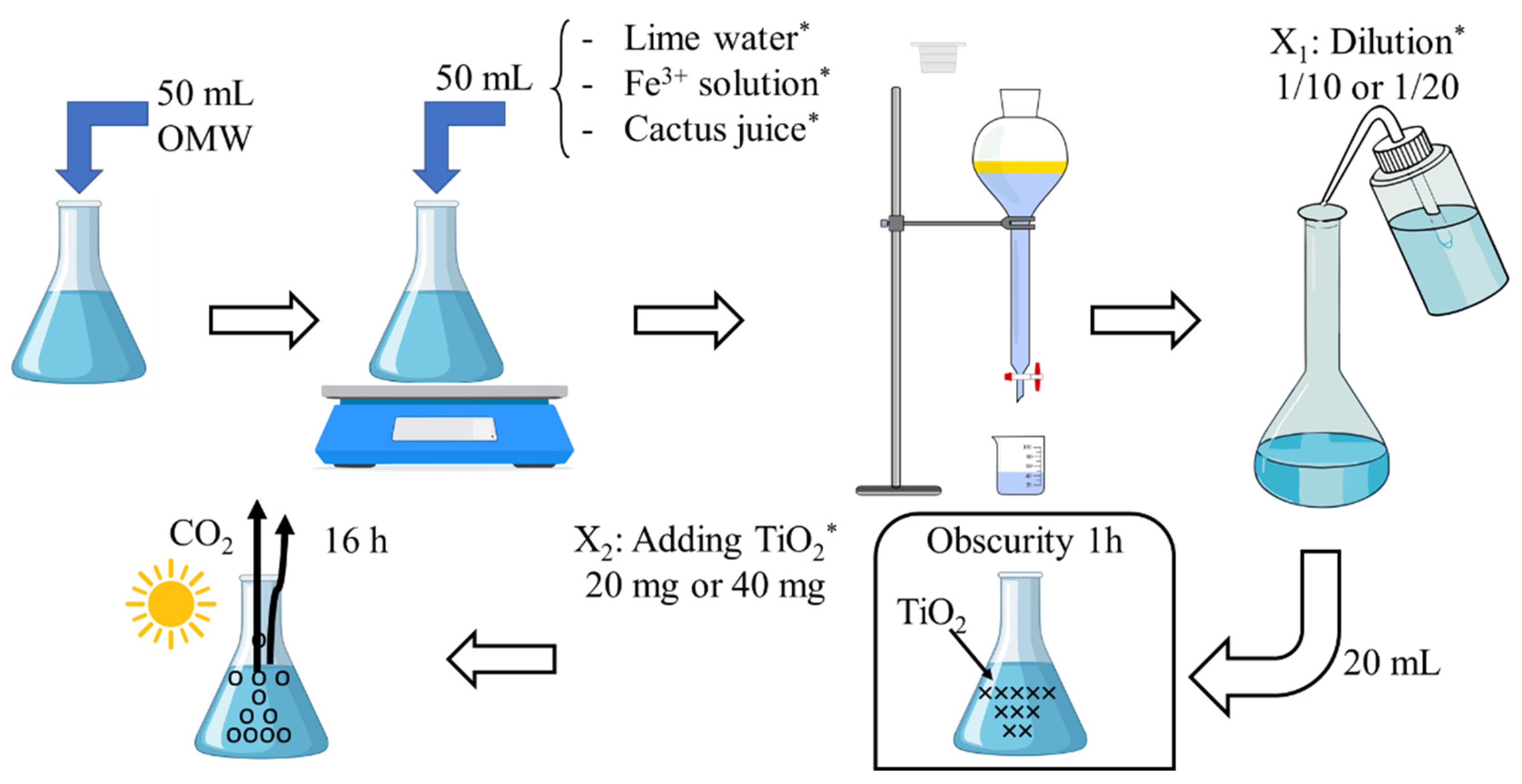
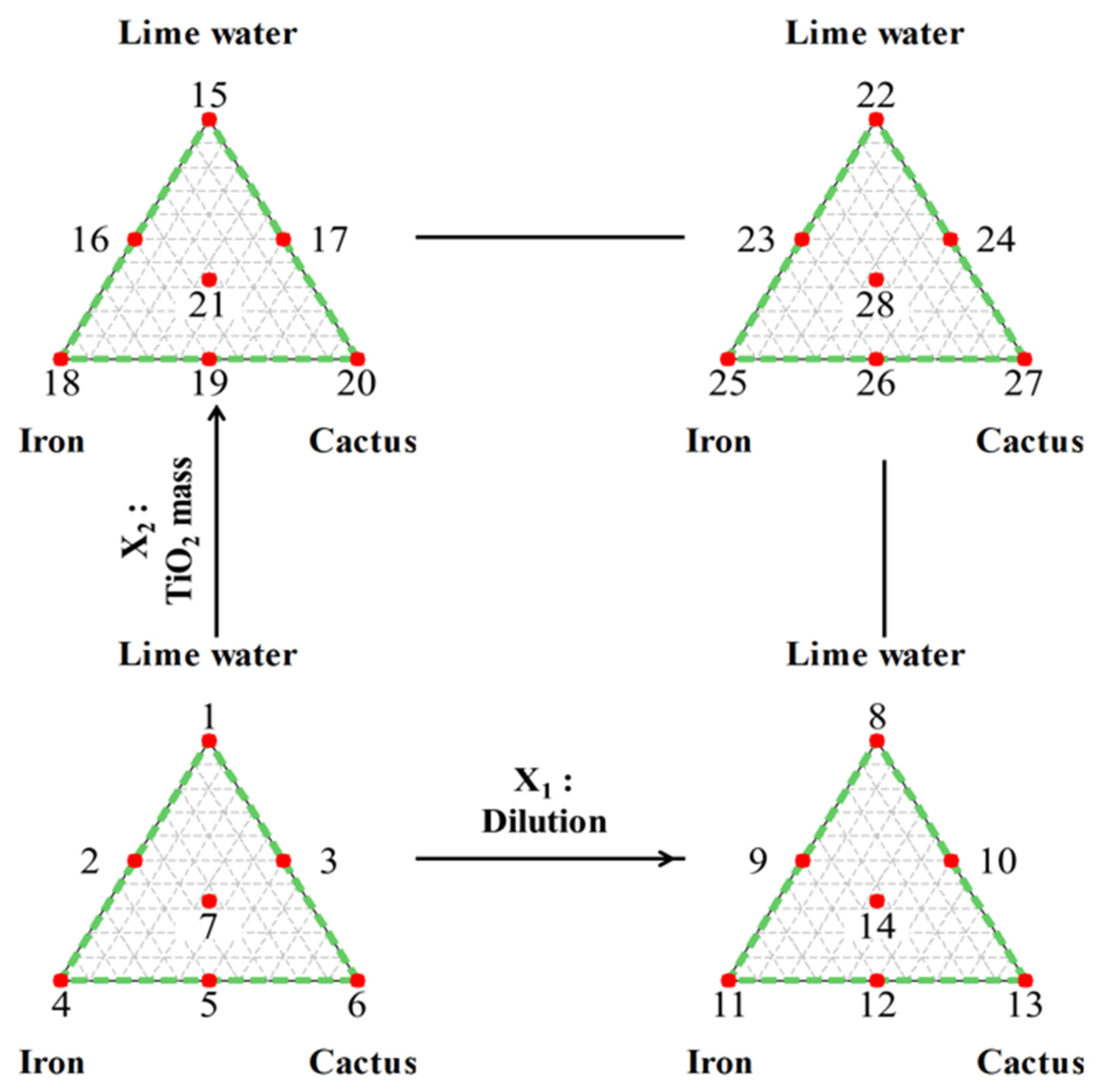
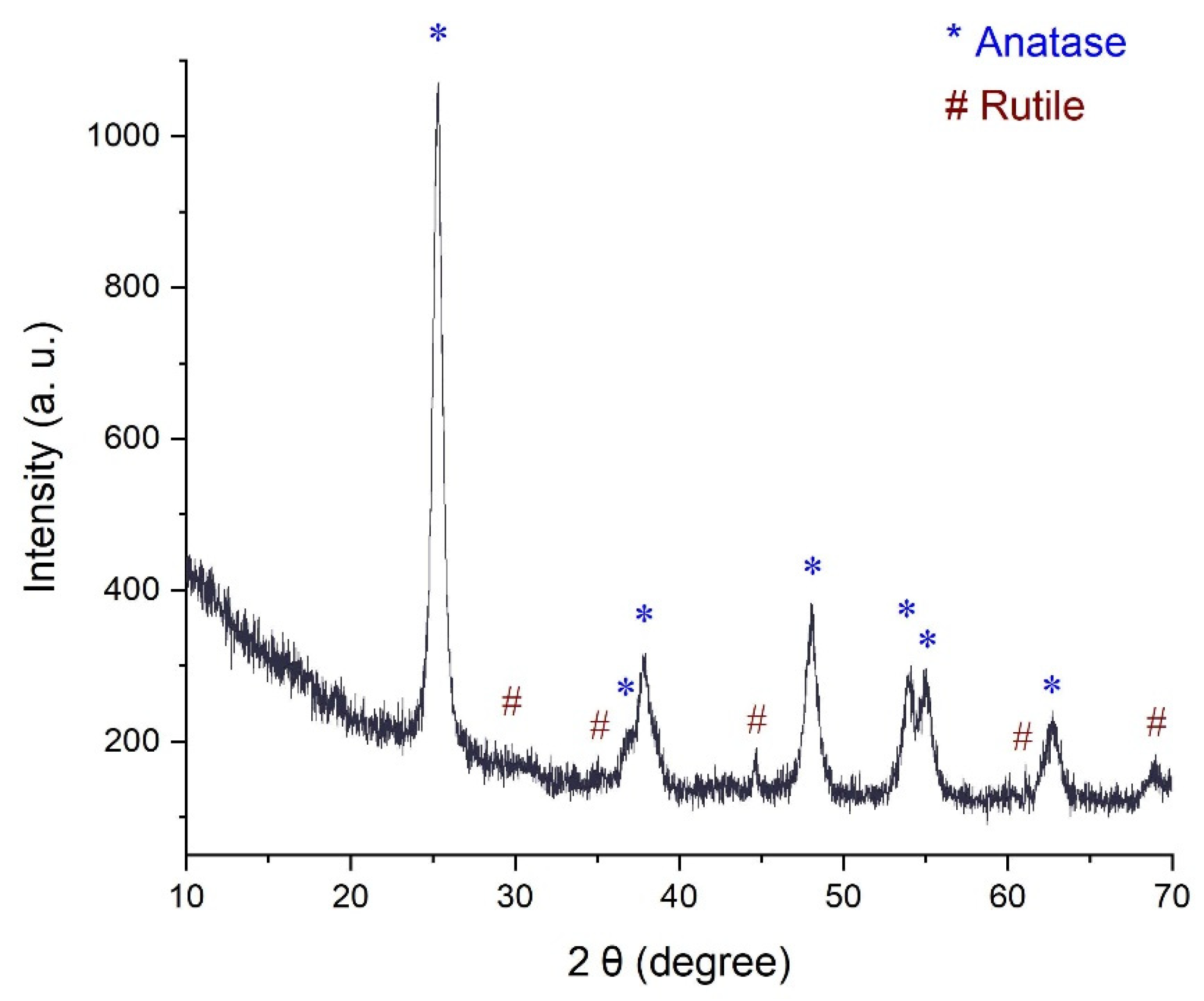
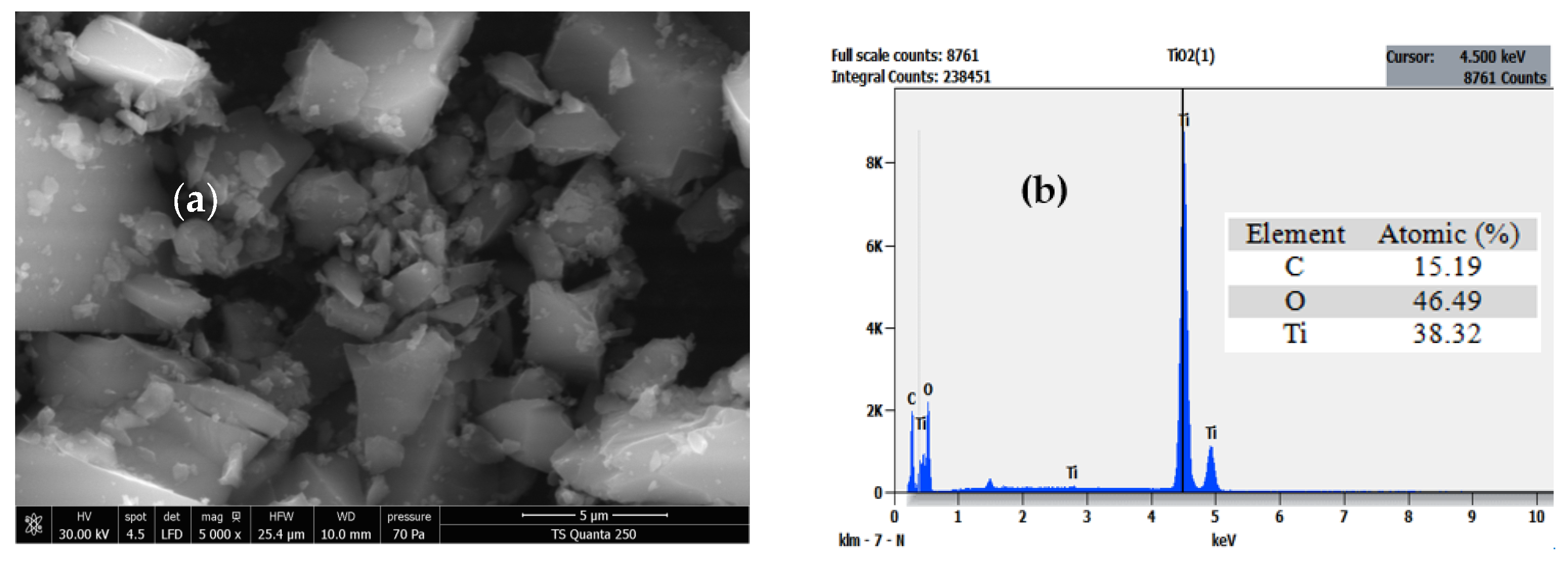
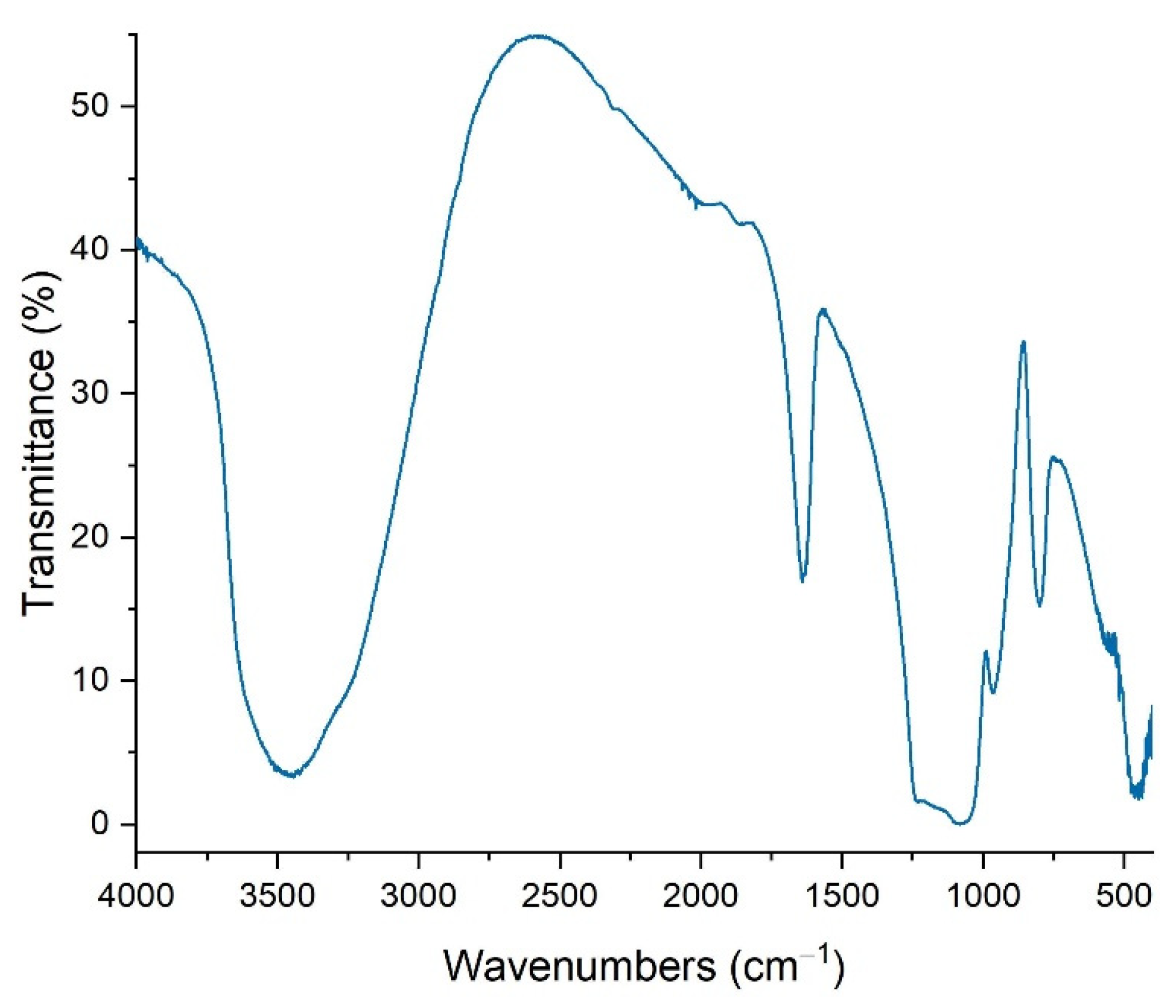

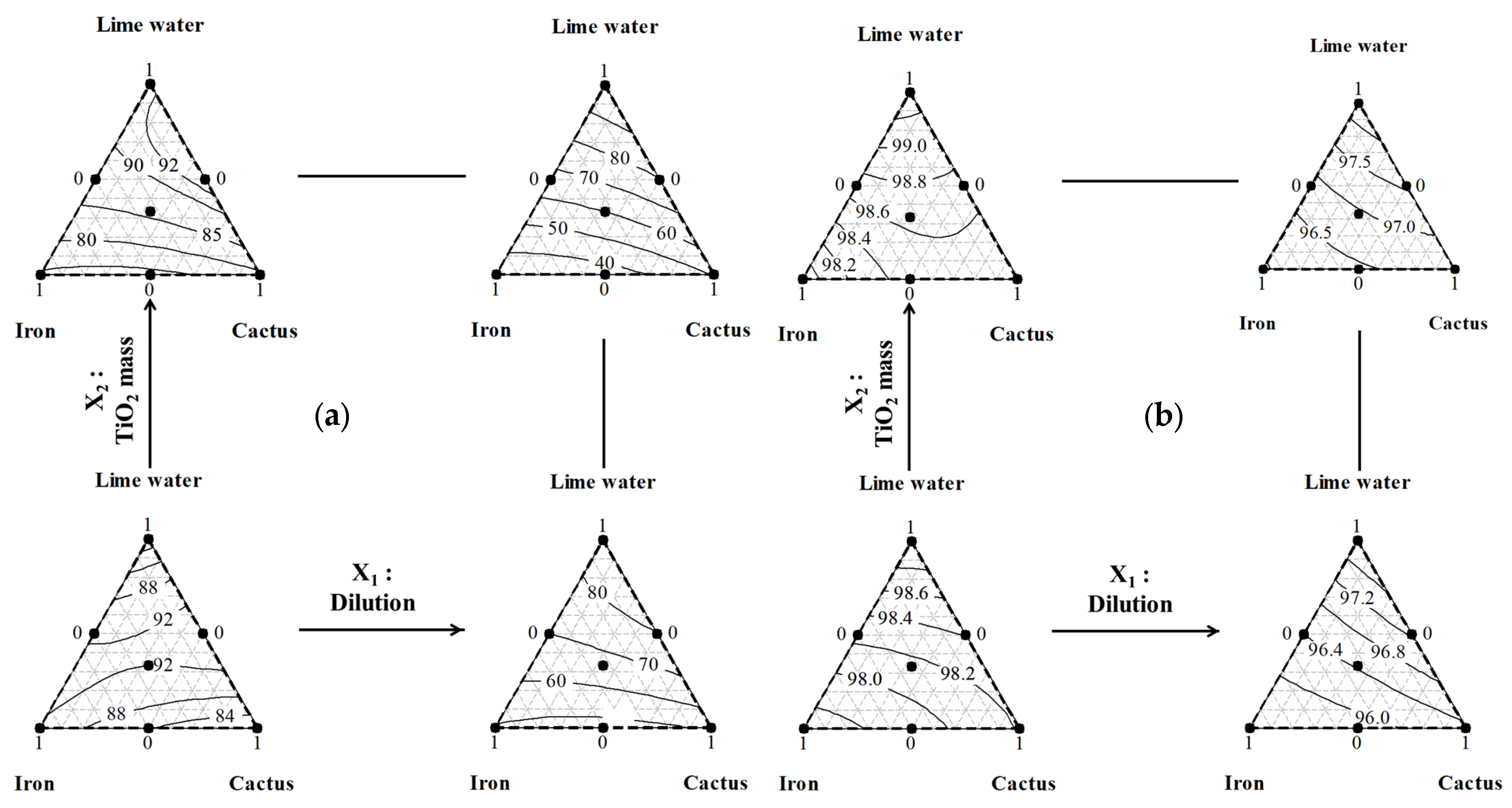
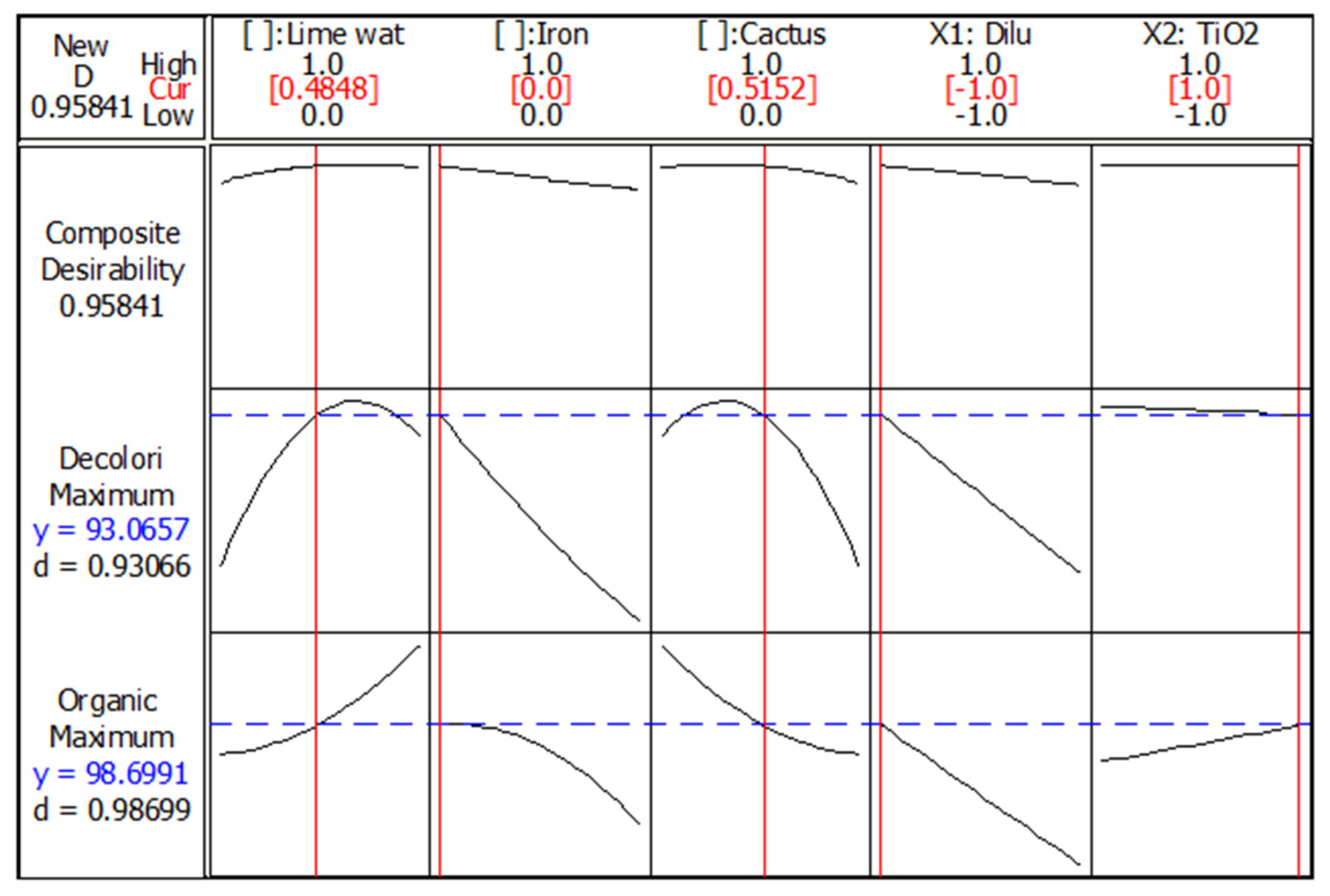
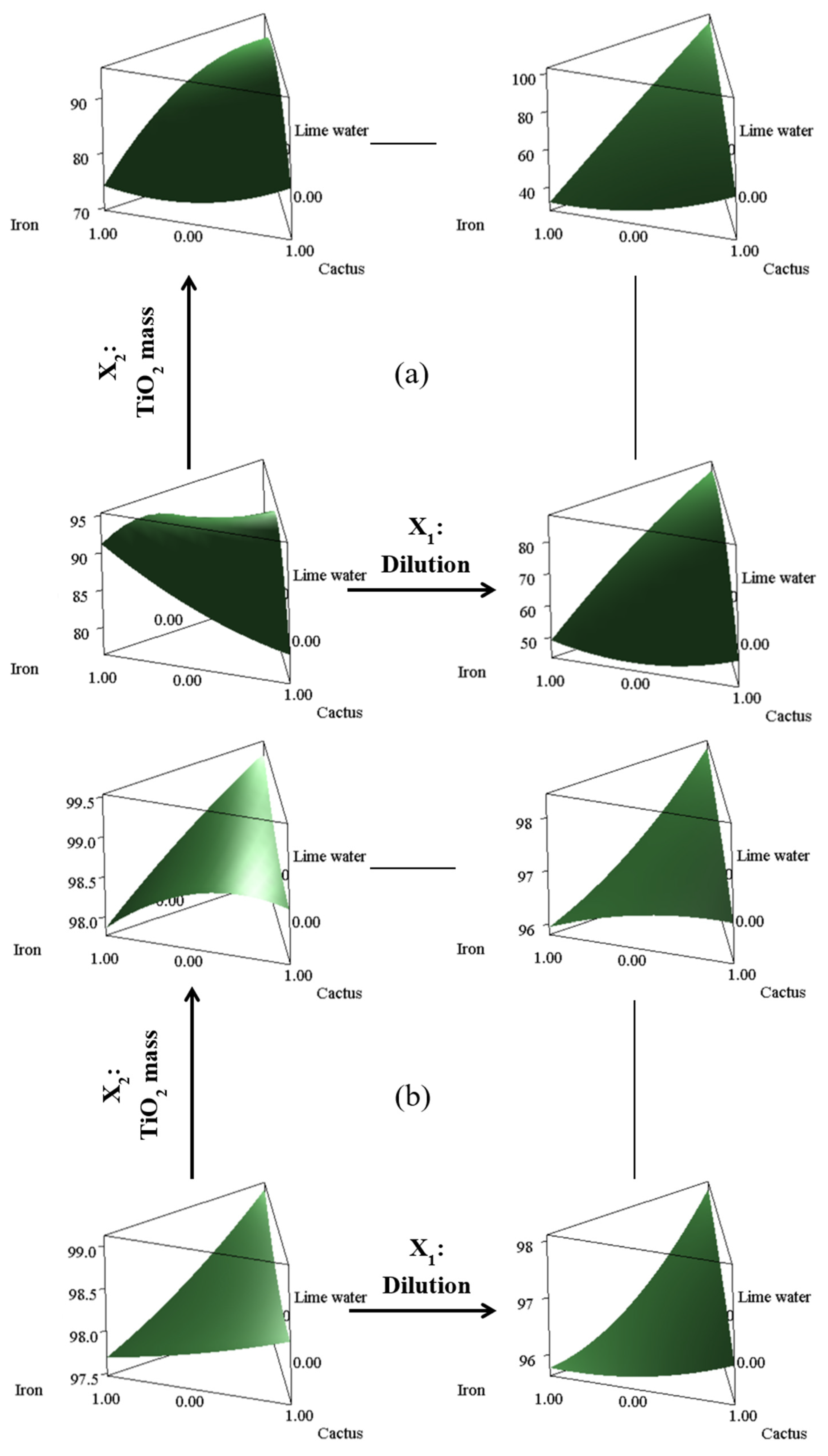
| Run | A * (vol. in mL) | B * (vol. in mL) | C * (vol. in mL) | X1 ** (Dilution Ratio in mL/mL) | X2 ** (TiO2 Mass in mg) | Decolorization (%) | Organic Degradation (%) |
|---|---|---|---|---|---|---|---|
| 12 | 0 (0 mL) | 1/2 (25 mL) | 1/2 (25 mL) | 1 (2 mL/10 mL) | −1 (20 mg) | 57.14 | 95.90 |
| 4 | 0 (0 mL) | 1 (50 mL) | 0 (0 mL) | −1 (1 mL/10 mL) | −1 (20 mg) | 97.36 | 97.60 |
| 9 | 1/2 (25 mL) | 1/2 (25 mL) | 0 (0 mL) | 1 (2 mL/10 mL) | −1 (20 mg) | 79.33 | 96.56 |
| 18 | 0 (0 mL) | 1 (50 mL) | 0 (0 mL) | −1 (1 mL/10 mL) | 1 (40 mg) | 66.69 | 97.92 |
| 24 | 1/2 (25 mL) | 0 (0 mL) | 1/2 (25 mL) | 1 (2 mL/10 mL) | 1 (40 mg) | 86.65 | 97.90 |
| 7 | 1/3 (16.7 mL) | 1/3 (16.7 mL) | 1/3 (16.7 mL) | −1 (1 mL/10 mL) | −1 (20 mg) | 90.84 | 98.02 |
| 17 | 1/2 (25 mL) | 0 (0 mL) | 1/2 (25 mL) | −1 (1 mL/10 mL) | 1 (40 mg) | 98.12 | 98.88 |
| 10 | 1/2 (25 mL) | 0 (0 mL) | 1/2 (25 mL) | 1 (2 mL/10 mL) | −1 (20 mg) | 90.53 | 97.50 |
| 6 | 0 (0 mL) | 0 (0 mL) | 1 (50 mL) | −1 (1 mL/10 mL) | −1 (20 mg) | 79.37 | 98.18 |
| 1 | 1 (50 mL) | 0 (0 mL) | 0 (0 mL) | −1 (1 mL/10 mL) | −1 (20 mg) | 67.63 | 99.02 |
| 27 | 0 (0 mL) | 0 (0 mL) | 1 (50 mL) | 1 (2 mL/10 mL) | 1 (40 mg) | 47.85 | 96.44 |
| 8 | 1 (50 mL) | 0 (0 mL) | 0 (0 mL) | 1 (2 mL/10 mL) | −1 (20 mg) | 92.45 | 97.94 |
| 20 | 0 (0 mL) | 0 (0 mL) | 1 (50 mL) | −1 (1 mL/10 mL) | 1 (40 mg) | 78.75 | 98.46 |
| 13 | 0 (0 mL) | 0 (0 mL) | 1 (50 mL) | 1 (2 mL/10 mL) | −1 (20 mg) | 50.22 | 96.30 |
| 3 | 1/2 (25 mL) | 0 (0 mL) | 1/2 (25 mL) | −1 (1 mL/10 mL) | −1 (20 mg) | 93.57 | 98.38 |
| 21 | 1/3 (16.7 mL) | 1/3 (16.7 mL) | 1/3 (16.7 mL) | −1 (1 mL/10 mL) | 1 (40 mg) | 76.69 | 98.46 |
| 26 | 0 (0 mL) | 1/2 (25 mL) | 1/2 (25 mL) | 1 (2 mL/10 mL) | 1 (40 mg) | 42.94 | 97.00 |
| 14 | 1/3 (16.7 mL) | 1/3 (16.7 mL) | 1/3 (16.7 mL) | 1 (2 mL/10 mL) | −1 (20 mg) | 43.52 | 96.06 |
| 25 | 0 (0 mL) | 1 (50 mL) | 0 (0 mL) | 1 (2 mL/10 mL) | 1 (40 mg) | 36.25 | 95.76 |
| 2 | 1/2 (25 mL) | 1/2 (25 mL) | 0 (0 mL) | −1 (1 mL/10 mL) | −1 (20 mg) | 92.54 | 98.32 |
| 23 | 1/2 (25 mL) | 1/2 (25 mL) | 0 (0 mL) | 1 (2 mL/10 mL) | 1 (40 mg) | 75.04 | 97.28 |
| 5 | 0 (0 mL) | 1/2 (25 mL) | 1/2 (25 mL) | −1 (1 mL/10 mL) | −1 (20 mg) | 83.97 | 98.10 |
| 28 | 1/3 (16.7 mL) | 1/3 (16.7 mL) | 1/3 (16.7 mL) | 1 (2 mL/10 mL) | 1 (40 mg) | 41.78 | 95.98 |
| 16 | 1/2 (25 mL) | 1/2 (25 mL) | 0 (0 mL) | −1 (1 mL/10 mL) | 1 (40 mg) | 91.11 | 98.78 |
| 11 | 0 (0 mL) | 1 (50 mL) | 0 (0 mL) | 1 (2 mL/10 mL) | −1 (20 mg) | 40.26 | 95.80 |
| 19 | 0 (0 mL) | 1/2 (25 mL) | 1/2 (25 mL) | −1 (1 mL/10 mL) | 1 (40 mg) | 78.57 | 98.42 |
| 22 | 1 (50 mL) | 0 (0 mL) | 0 (0 mL) | 1 (2 mL/10 mL) | 1 (40 mg) | 87.32 | 98.20 |
| 15 | 1 (50 mL) | 0 (0 mL) | 0 (0 mL) | −1 (1 mL/10 mL) | 1 (40 mg) | 99.59 | 99.36 |
| System | Degradation Yield | Reference |
|---|---|---|
| TiO2 (P25)/UV365 nm | Degradation of 94% phenols; 57% colored compounds | [49] |
| Carbon-doped TiO2/visible light 400–800 nm | More than 80% phenol degradation | [50] |
| Doped TiO2/visible light 400–800 nm | Quantitative degradation of organic compounds | [51] |
| Nitrogen-doped TiO2 supported on Zeolite/visible light 400–800 nm | Total degradation of organic compounds | [52] |
| Composition | Lime (50 mL) | Fe3+ sol. (50 mL) | Cactus (50 mL) | Lime: Fe3+ sol. (25 mL: 25 mL) | Lime:Cactus (25 mL: 25 mL) | Fe3+ sol.:Cactus (25 mL: 25 mL) | Lime:Fe3+ sol.:Cactus (16.7 mL: 16.7 mL: 16.7 mL) | |
|---|---|---|---|---|---|---|---|---|
| Response | ||||||||
| Decolorization (%) | 53.8 | 14.6 | 22.8 | 46.7 | 60.0 | 23.9 | 17.4 | |
| Organic degradation (%) | 85.4 | 80.2 | 83.3 | 71.0 | 71.0 | 84.6 | 56.7 | |
| Decolorization (%) | Organic Degradation (%) | |||||||
|---|---|---|---|---|---|---|---|---|
| Term | Coef. | SE Coef. | t | p | Coef. | SE Coef. | t | p |
| Component Only | ||||||||
| Linear | ||||||||
| Lime water (A) | 88.18 | 7.18 | − | 0.054 | 98.68 | 0.22 | − | <0.001 |
| Fe3+ solution (B) | 61.58 | 7.18 | − | 0.054 | 96.82 | 0.22 | − | <0.001 |
| Cactus juice (C) | 65.48 | 7.18 | − | 0.054 | 97.39 | 0.22 | − | <0.001 |
| Quadratic | ||||||||
| A × B | 15.50 | 33.02 | 0.47 | 0.649 | −0.79 | 1.03 | −0.76 | 0.462 |
| A × C | 38.54 | 33.02 | 1.17 | 0.270 | −0.22 | 1.03 | −0.21 | 0.838 |
| B × C | −14.50 | 33.02 | −0.44 | 0.600 | 0.27 | 1.03 | 0.26 | 0.801 |
| Component × X1: Dilution | ||||||||
| Linear | ||||||||
| A × X1 | 3.99 | 7.18 | 0.56 | 0.591 | −0.53 | 0.22 | −2.38 | 0.039 |
| B × X1 | −21.03 | 7.18 | −2.93 | 0.015 | −0.96 | 0.22 | −4.31 | 0.002 |
| C × X1 | −14.16 | 7.18 | −1.97 | 0.077 | −0.95 | 0.22 | −4.24 | 0.002 |
| Quadratic | ||||||||
| A × B × X1 | −8.83 | 33.02 | −0.27 | 0.794 | −0.73 | 1.03 | −0.71 | 0.492 |
| A × C × X1 | −7.81 | 33.02 | −0.24 | 0.818 | 0.64 | 1.03 | 0.62 | 0.548 |
| B × C × X1 | −5.71 | 33.02 | −0.17 | 0.866 | −0.26 | 1.03 | −0.26 | 0.804 |
| Component × X2: TiO2 mass | ||||||||
| Linear | ||||||||
| A × X2 | 6.81 | 7.184 | 0.95 | 0.365 | 0.17 | 0.223 | 0.75 | 0.469 |
| B × X2 | −8.57 | 7.184 | −1.19 | 0.261 | 0.09 | 0.223 | 0.39 | 0.702 |
| C × X2 | −0.64 | 7.184 | −0.09 | 0.930 | 0.12 | 0.223 | 0.55 | 0.594 |
| Quadratic | ||||||||
| A × B × X2 | −3.89 | 33.02 | −0.12 | 0.909 | 0.38 | 1.03 | 0.37 | 0.718 |
| A × C × X2 | −13.34 | 33.02 | −0.40 | 0.695 | 0.03 | 1.03 | 0.03 | 0.976 |
| B × C × X2 | −2.86 | 33.02 | −0.09 | 0.933 | 0.71 | 1.03 | 0.69 | 0.504 |
Disclaimer/Publisher’s Note: The statements, opinions and data contained in all publications are solely those of the individual author(s) and contributor(s) and not of MDPI and/or the editor(s). MDPI and/or the editor(s) disclaim responsibility for any injury to people or property resulting from any ideas, methods, instructions or products referred to in the content. |
© 2024 by the authors. Licensee MDPI, Basel, Switzerland. This article is an open access article distributed under the terms and conditions of the Creative Commons Attribution (CC BY) license (https://creativecommons.org/licenses/by/4.0/).
Share and Cite
Fakhfakh, F.; Raissi, S.; Kriaa, K.; Maatki, C.; Kolsi, L.; Hadrich, B. Modeling and Optimization of a Green Process for Olive Mill Wastewater Treatment. Water 2024, 16, 327. https://doi.org/10.3390/w16020327
Fakhfakh F, Raissi S, Kriaa K, Maatki C, Kolsi L, Hadrich B. Modeling and Optimization of a Green Process for Olive Mill Wastewater Treatment. Water. 2024; 16(2):327. https://doi.org/10.3390/w16020327
Chicago/Turabian StyleFakhfakh, Fatma, Sahar Raissi, Karim Kriaa, Chemseddine Maatki, Lioua Kolsi, and Bilel Hadrich. 2024. "Modeling and Optimization of a Green Process for Olive Mill Wastewater Treatment" Water 16, no. 2: 327. https://doi.org/10.3390/w16020327
APA StyleFakhfakh, F., Raissi, S., Kriaa, K., Maatki, C., Kolsi, L., & Hadrich, B. (2024). Modeling and Optimization of a Green Process for Olive Mill Wastewater Treatment. Water, 16(2), 327. https://doi.org/10.3390/w16020327








